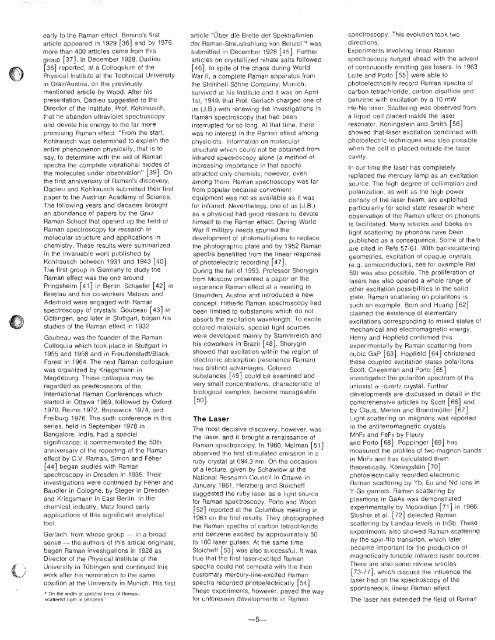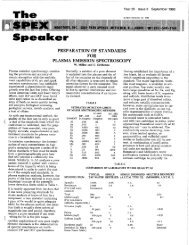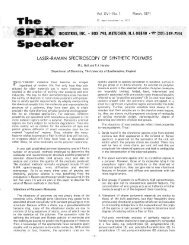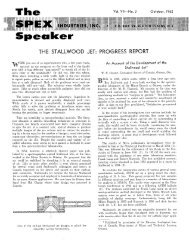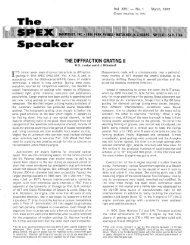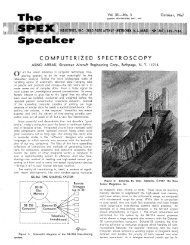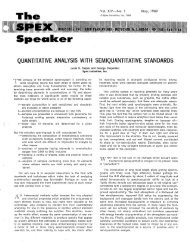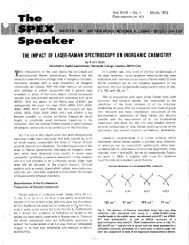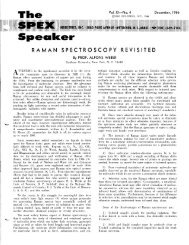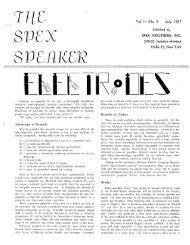Raman Anniversary Issue - Golden Jubilee Of The ... - SPEX Speaker
Raman Anniversary Issue - Golden Jubilee Of The ... - SPEX Speaker
Raman Anniversary Issue - Golden Jubilee Of The ... - SPEX Speaker
You also want an ePaper? Increase the reach of your titles
YUMPU automatically turns print PDFs into web optimized ePapers that Google loves.
A<br />
We]<br />
{_)<br />
early to the <strong>Raman</strong> effect. Bonino's first<br />
article appeared in 1929 (36] and by 1976<br />
more than 400 articles came from this<br />
group [37]. In December 1928, Dadieu<br />
[38] reported, at a Colloquium of the<br />
Physical Institute at the Technical University<br />
in Graz/Austria. on the previously<br />
mentioned article by Wood. After his<br />
presentation, Oadieu suggested to the<br />
Director of the Institute, Prof. Kohlrausch.<br />
that he abandon ultraviolet spectroscopy<br />
and devote his energy to the far more<br />
promising <strong>Raman</strong> effect. "From the start.<br />
Kohlrausch was determined to explain the<br />
entire phenomenon physically, that is to<br />
say, to determine with the aid of <strong>Raman</strong><br />
spectra the complete vibrational modes of<br />
the molecules under observation'' [39]. On<br />
the first anniversary of <strong>Raman</strong>'s discovery,<br />
Dadieu and Kohlrausch submitted their first<br />
paper to the Austrian Academy of Science.<br />
<strong>The</strong> following years and decades brougllt<br />
an abundance of papers by the Graz<br />
<strong>Raman</strong> School that opened up the field of<br />
<strong>Raman</strong> spectroscopy for research in<br />
molecular structure and applications in<br />
chemistry. <strong>The</strong>se results were summarized<br />
in the invaluable work published by<br />
Kohlrausch between 1931 and 1943 [40]<br />
<strong>The</strong> first group in Germany to study the<br />
<strong>Raman</strong> effect was the one around<br />
Pringsheim [41] in Berlin. Schaefer [42] in<br />
Breslau and his co-workers Matossi and<br />
Aderhold were engaged with <strong>Raman</strong><br />
spectroscopy of crystals. Goubeau [ 43] in<br />
GOttingen, and later in Stuttgart, began his<br />
studies of the <strong>Raman</strong> effect in 1932.<br />
Goubeau was the founder of the <strong>Raman</strong><br />
Colloquia which took place in Stuttgart in<br />
1955 and 1958 and in Freudenstadt!Biack<br />
Forest in 1964. <strong>The</strong> next <strong>Raman</strong> colloquium<br />
was organized by Kriegsmann in<br />
Magdeburg. <strong>The</strong>se colloquia may be<br />
regarded as predecessors of the<br />
International <strong>Raman</strong> Conferences wllich<br />
started in Ottawa 1969, followed by Oxford<br />
1970, Reims 1972, Brunswick 1974, and<br />
Freibur"g 1976. <strong>The</strong> sixth conference in this<br />
series, held in September i978 in<br />
Bangalore, India, had a special<br />
significance: it commemorated the 50th<br />
anniversary of the reporting of the <strong>Raman</strong><br />
effect by C.V. <strong>Raman</strong>. Simon and Feher<br />
[ 44] began studies with <strong>Raman</strong><br />
spectroscopy in Dresden in 1935. <strong>The</strong>ir<br />
investigations were continued by F8her and<br />
Baudler in Cologne, by Steger in Dresden<br />
and Kriegsmann in East Berlin. In the<br />
ct1emical industry, Matz found early<br />
applications of this significant analytical<br />
tool.<br />
Gerlach, from whose group - in a broad<br />
sense~ the authors of this article originate,<br />
began <strong>Raman</strong> investigations in 1928 as<br />
Director of the Physical Institute of the<br />
University in TObingen and continued this<br />
work after his nomination to the same<br />
position at 01e University in Munich. His first<br />
''"On the w1dlh of spectral lmes ol A


